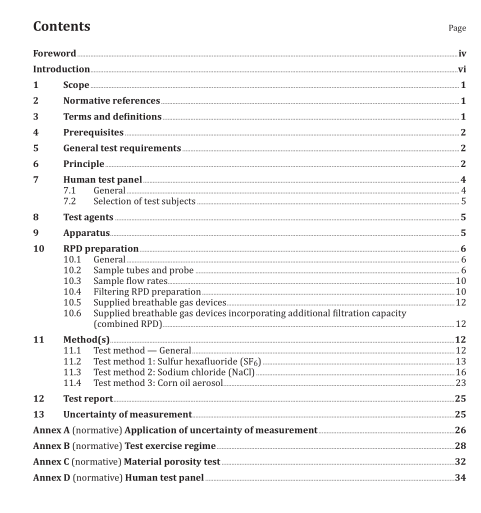ISO 16900-1:2014 pdf download.Respiratory protective devices — Methods of test and test equipment — Part 1: Determination of inward leakage
This part of ISO 16900 specifies the test methods for determining inward leakage of respiratory interfaces (RI) and total inward leakage of complete respiratory protective devices (RPD) using specified test agents and incorporating specified body movements, at specified metabolic work rates.
These tests are conducted in laboratories using specific test agents under specified conditions and therefore do not indicate the performance of the device in actual use.
2 Normative references
The following documents, in whole or in part, are normatively referenced in this document and are indispensable for its application. For dated references, only the edition cited applies. For undated references, the latest edition of the referenced document (including any amendments) applies.
ISO 16972, Respiratory protective devices — Terms, definitions, graphical symbols and units of measurement
ISO 16900-5 1) , Respiratory protective devices — Methods of test and test equipment — Part 5: Breathing machine/metabolic simulator/RPD headforms/torso, tools and transfer standards
ISO 17420-3, Respiratory protective devices — Performance requirements — Part 3: Thread connection
ISO 21748, Guidance for the use of repeatability, reproducibility and trueness estimates in measurement uncertainty estimation
ISO/TS 16976-2:2010, Respiratory protective devices — Human factors — Part 2: Anthropometrics
3 Terms and definitions
For the purposes of this document, the terms and definitions in ISO 16972 and the following apply.
3.1 assisted filtering RPD
filtering RPD in which air is moved through the filter(s) by means of a blower in addition to the breathing of the wearer
3.2 porous device
RPD incorporating materials, excluding filters, that can be penetrated by gases and vapours during an inward leakage test, leading to an increase of the inward leakage
3.3 unassisted filtering RPD
filtering RPD in which air is drawn through the filter(s) solely by the breathing of the wearer
4 Prerequisites
The performance standard shall indicate the conditions of the test. This includes the following:
a) minimum number of test specimens;
b) number of test subjects and selection criteria;
c) operating conditions of the RPD;
d) if appropriate, test method (including test agent and sampling methods) to be used;
e) the exercise regime to be used;
f) if appropriate, the use of crosswinds during particular test exercises;
g) any exclusions from the test exercise regimes of Annex B;
h) any prior conditioning, sequence of preconditioning, and/or testing required;
i) any optional features of the RPD to be included in the assessment;
j) characteristics to be assessed subjectively (if appropriate).
5 General test requirements
Unless otherwise specified, the values stated in this part of ISO 16900 are expressed as nominal values. Except for temperature limits, values which are not stated as maxima or minima shall be subject to a tolerance of ±5 %. Unless otherwise specified, the ambient conditions for testing shall be between 16 °C and 32 °C and (50 ± 30) % RH. Any temperature limits specified shall be subject to an accuracy of ±1 °C.
6 Principle
A test subject wearing the RPD being tested performs a series of exercises while surrounded by an atmosphere containing a known concentration of a test substance. During these exercises, the concentration of the test substance inside and outside the respiratory interface (RI) is measured and compared. Three test agents are specified: one solid aerosol, one liquid aerosol, and a gas. The general principle of the test is the same for all substances. The test agent(s) used depend on the type of RPD being tested and are chosen according to Figure 1.
NOTE Where a choice of gas or aerosol is permitted according to Figure 1, the aerosol test methods are preferred since SF 6 is regarded to be a greenhouse gas and its use is deemed undesirable where it could be avoided.
7 Human test panel
7.1 General
7.1.1 Before performing tests involving human test panels, account should be taken of any national or other regulations concerning, for example the medical history, any know allergies, examination, or supervision of the test subjects.ISO 16900-1 pdf download.ISO 16900-1 pdf download
